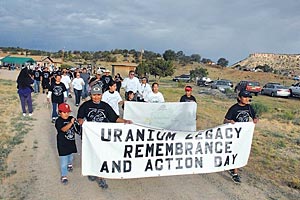
Study: Uranium, radiation persist in Blue Gap

The 32nd anniversary of the Church Rock uranium tailings spill was observed July 16 with an awareness march starting from the home of Teddy Nez to the site of the uranium tailings spill in Church Rock, N.M. July 2011
BLUE GAP, Ariz.
For years, the people of Blue Gap/Tachee Chapter have nervously eyed the abandoned uranium mines on the mesa above their homes, wondering if there is still uranium in the soil that washes down into their yards with every rainstorm.
In 1988, the chapter passed the first of two resolutions pleading for help in studying and remediating the mines.
Nearly 30 years later, the stars finally aligned for such a study. And it confirmed their worst fears.
Last Friday at a regularly scheduled chapter meeting, chapter members learned that uranium levels in a spring and seep that used to be sources for drinking water in the 1960s were about five times what the Environmental Protection Agency deems safe.
Gamma radiation levels were measured at the largest uranium mine, Claim 28, where 4,181 tons of uranium were removed during the 1950s and 1960s.
Although the mine tailings were pushed into pits and buried by the Navajo Nation’s Abandoned Mine Lands Department in 1991 and 1992, gamma radiation at the site was still 20 to almost 40 times higher than the background rate of 13 microroentgens per hour, reported scientists from the University of New Mexico, who had worked with the Southwest Research and Information Center under a grant from the National Science Foundation.
Average background gamma radiation in the U.S. varies between 6 and 40 microroentgens. Samples at the mine went as high as 401.
Also mined and present in boulders that occasionally roll down the mesa is vanadium — a heavy metal that is not regulated by the EPA but is radioactive in some phases and may have effects on human health.
The mostly elderly crowd listened quietly as Blue Gap/Tachee Chapter President Aaron Yazzie translated the scientific data into Navajo as best he could.
The data is clear: there is plenty of radioactive material left in a mine that is less than half a mile from some homesites. What to do with this newfound information is less clear.
To read the full article, pick up your copy of the Navajo Times at your nearest newsstand Thursday mornings!
Are you a digital subscriber? Read the most recent three weeks of stories by logging in to your online account.








 Highway 264,
Highway 264, I-40, WB @ Winslow
I-40, WB @ Winslow